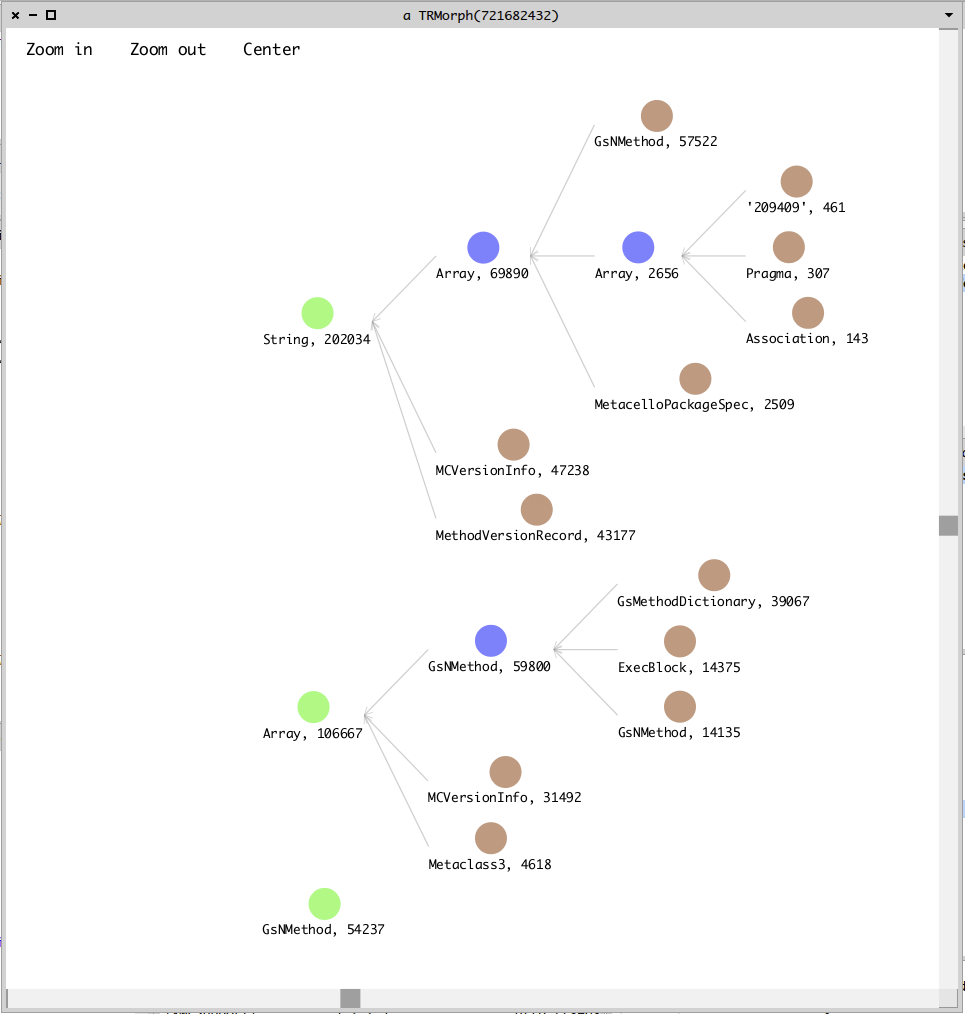Tech Tip: GSS-0045
Last Updated June 29, 2016
applies to GemStone/S 64 Bit 3.2.x and earlier and 32-bit GemStone/S
As your GemStone repository grows over time, the question may arise about which objects are using that space and how many of them there are, and which classes the objects are. The transparency that makes persistence simple can make it more difficult to see the relationship to the number and classes of objects. There are a number of ways to examine the contents of your repository.
GsObjectInventory
In GemStone/S 64 Bit versions 2.0 and later, the GsObjectInventory class provides a way to scan your repository and produce a number of reports on the number of instances of all classes in the repository. This performs a scan of the entire repository, which takes some time in larger systems.
For example:
topaz 1> run GsObjectInventory profileRepository instanceCountReportDownTo: 200 % *** GsObjectInventory instanceCountReport printed at: 28/06/2016 11:14:56 *** Hidden classes are included in this report. ________________________________________________________________________________ Class Instances Bytes ________________________________________________________________________________ String 45055 11956544 Array 26755 4140640 GsNMethod 22387 4483000 Symbol 19790 881816 SymbolAssociation 5230 209840 SymbolSet 4539 152552 GsMethodDictionary 3420 1793624 SupportedConfiguration 3417 382704 ExecBlock 3319 212728 OsConfiguration 2396 210864 CanonStringBucket 2017 304280 Class 1676 261688 IdentityKeyValueDictionary 1537 209096 IdentityCollisionBucket 1418 152296 SymbolDictionary 887 151112 ClassHistory 837 40400 ByteArray 782 26232 CCallout 762 73152 DepListBucket 751 42064 DateTime 708 39728 ClientSmalltalkConfiguration 525 33624 TimeZoneTransition 313 17560 ________________________________________________________________________________
ScanBackup
ScanBackup is a tool that allows you to read and parse a backup file to produce an instance count of the objects that were written to the backup file. This code is provided as a filein here.
This code works in 32-bit GemStone/S (tested on v6.7), as well as GemStone/S 64 bit 2.x, 3.1.x and 3.2.x.
To use, file in ScanBackup.gs and commit. Then execute the following, using the appropriate class depending on if you are in 32-bit GemStone/S or GemStone/S 64 bit.
API in GemStone/S 64-bit
ScanBackup64 scanBackupAtServerPath: 'path-to-backup-file'
32-bit GemStone/S:
ScanBackup32 scanBackupAtServerPath: 'path-to-backup-file'
For example:
topaz 1> run SystemRepository fullBackupTo: 'bkup.dat' % true topaz 1> run ScanBackup64 scanBackupAtServerPath: 'bkup.dat' % 1 45055 String 2 26755 Array 3 22387 GsNMethod 4 19790 Symbol 5 5230 SymbolAssociation 6 4539 SymbolSet 7 3420 GsMethodDictionary 8 3417 SupportedConfiguration 9 3319 ExecBlock 10 2396 OsConfiguration 11 2017 CanonStringBucket 12 1537 IdentityKeyValueDictionary 13 1418 IdentityCollisionBucket 14 887 SymbolDictionary 15 838 Metaclass3 16 837 ClassHistory 17 782 ByteArray 18 762 CCallout 19 751 DepListBucket 20 708 DateTime 21 525 ClientSmalltalkConfiguration 22 313 TimeZoneTransition 23 195 Association 24 150 CPreprocessorToken 25 106 EqualityCollisionBucket
It is not strictly required to execute this in the same environment as the backup, however, class OOPs in the backup file are translated to class names based on the current image and may be incorrect for non-kernel classes in an unrelated repository, or a different GemStone product.
Obex
Obex (Object Explorer) is a open-source project that allows you to visualize objects within the repository and interactively explore the contents. This project is currently under active development. See the obex project page on github for current status.
As an example of the design of this set of tools, this diagram shows object counts and the class and number of in instances that reference those objects:

